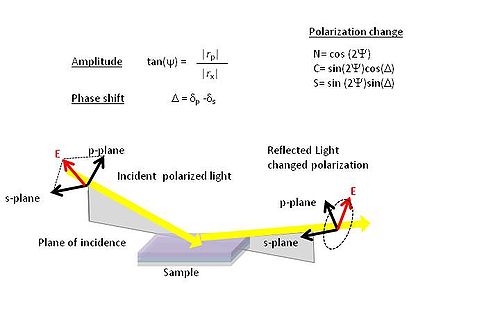Difference between revisions of "Ellipsometer"
Cmditradmin (talk | contribs) m (→Operation) |
|||
| (38 intermediate revisions by the same user not shown) | |||
| Line 1: | Line 1: | ||
<table id="toc" style="width: 100%"> | |||
<tr> | |||
<td style="text-align: center; width: 33%">[[Main_Page#Research Equipment, Devices and Techniques|Return to Research Tool Menu]]</td> | |||
</tr> | |||
</table> | |||
=== Overview === | === Overview === | ||
An elipsometer is used measure the dielectric properties (including refractive index and dielectric function) of thin films. It is useful for determining these properties | |||
*film thickness | |||
*refractive indices | |||
*surface roughness | |||
*interfacial mixing | |||
*composition | |||
*crystallinity | |||
*anisotropy | |||
*uniformity | |||
=== Significance === | |||
[[Image:Ellipsometry.JPG|thumb|500px|The polarization of light is often an ellipse]] | |||
The ellipsometer directly measures Ψ the amplitude ratio and Δ the phase difference of the polarization of light as it reflects off a sample surface. The data is collected at several incident angles and across a broad spectrum of wavelengths. Given these parameters the data is then fit to a set of mathematical models that is appropriate for the materials or multiple layers of materials. Once the other parameters are adjusted and the curves are properly fit, the desired property can be inferred. | |||
<math>\rho</math> (a complex quantity), which is the ratio of <math>r_p</math> over <math>r_s</math>: | |||
:<math>\rho = \frac{r_p}{r_s} = \tan ( \Psi ) e^{i \Delta}</math> | |||
:<math>\Delta = \delta_p - \delta_s\,\!</math> is the phase difference | |||
:<math>\Psi\,\!</math> is the amplitude ratio | |||
Other common variables associated with this are; | |||
=== | :<math>N= cos(2\Psi)\,\!</math> | ||
:<math>C= sin(2\Psi) cos (\Delta)\,\!</math> | |||
:<math>S= sin(2\Psi) sin (\Delta)\,\!</math> | |||
<div id="Flash">'''Kinds of polarization simulation'''</div> | |||
This simulations shows linear, circular and elliptical polarization. Click the buttons to select a phase delay for the the waves and then press play. | |||
<swf width=500 height=400>/images/7/75/Wavepolar_sim.swf</swf> | |||
=== Operation === | |||
{{#ev:youtube|Ff8jiTu1qg0}} | |||
<embed_document width="100%" height="400">images/d/de/Ellipsometry.pdf</embed_document> | |||
{{#ev:youtube|cuKiH0seG6U}} | |||
[http://grover.mirc.gatech.edu/training/viewVideo.php?video=wollam-high&size=0 Video on Woolam Ellipsometer at MiRC] | |||
[http://www5.cnf.cornell.edu/EQ-Training/Woollam.mp4 Video on Woolam Ellipsometer at Cornell] | |||
=== External Links === | |||
*[[wikipedia:Ellipsometry]] | |||
*[[wikipedia:Polarization_(waves)]] | |||
*[http://www.jawoollam.com/tutorial_1.html Woolam Ellipsometry Tutorial] | |||
Latest revision as of 14:54, 14 November 2011
| Return to Research Tool Menu |
Overview
An elipsometer is used measure the dielectric properties (including refractive index and dielectric function) of thin films. It is useful for determining these properties
- film thickness
- refractive indices
- surface roughness
- interfacial mixing
- composition
- crystallinity
- anisotropy
- uniformity
Significance
The ellipsometer directly measures Ψ the amplitude ratio and Δ the phase difference of the polarization of light as it reflects off a sample surface. The data is collected at several incident angles and across a broad spectrum of wavelengths. Given these parameters the data is then fit to a set of mathematical models that is appropriate for the materials or multiple layers of materials. Once the other parameters are adjusted and the curves are properly fit, the desired property can be inferred.
<math>\rho</math> (a complex quantity), which is the ratio of <math>r_p</math> over <math>r_s</math>:
- <math>\rho = \frac{r_p}{r_s} = \tan ( \Psi ) e^{i \Delta}</math>
- <math>\Delta = \delta_p - \delta_s\,\!</math> is the phase difference
- <math>\Psi\,\!</math> is the amplitude ratio
Other common variables associated with this are;
- <math>N= cos(2\Psi)\,\!</math>
- <math>C= sin(2\Psi) cos (\Delta)\,\!</math>
- <math>S= sin(2\Psi) sin (\Delta)\,\!</math>
This simulations shows linear, circular and elliptical polarization. Click the buttons to select a phase delay for the the waves and then press play. <swf width=500 height=400>/images/7/75/Wavepolar_sim.swf</swf>
Operation
<embed_document width="100%" height="400">images/d/de/Ellipsometry.pdf</embed_document>
Video on Woolam Ellipsometer at MiRC
Video on Woolam Ellipsometer at Cornell
